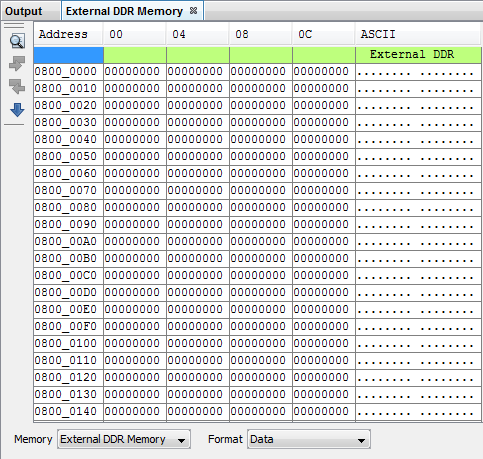The External Memory window displays the contents of external memory by bus type:
- External Bus Interface (EBI)
- Serial Quad Interface (SQI)
- Double Data Rate (DDR)

The External Memory window displays the contents of external memory by bus type:

To see external memory contents in this window:
You may specify how memory is displayed in the window by selecting from the Format drop-down box on the bottom of the window:
Code Format
This window will have the following columns:
Data Format
This window will have the following columns:
Icons are located on the left side of the window.
| Icon | Icon Text | Function |
|---|---|---|
 |
Refresh by Read Device Memory | Same function as the Debug toolbar “Read Device Memory” icon - uploads device memory to the MPLAB X IDE. |
 |
Find | Specify a string to find in the window. Select to match whole word or case. |
 |
Find Next | Find next instance of string from Find. |
 |
Find Previous | Find previous instance of string from Find. |
 |
Go To | Go to specified line number or address. |
Right click in the memory window data area set to CODE FORMAT to pop up this menu. Not all items may be visible for all 32-bit MCUs.
| Item | Description |
|---|---|
| External
Address (KSEG[2:3]) |
Select addresses for display. See your device data sheet for details. |
| Physical Address | Select physical addresses for display. |
| Run to Cursor | Run the program to the current cursor location. |
| Step Instruction | Perform a step instruction. |
| Set PC at Cursor | Set the Program Counter (PC) to the cursor location. |
| Focus Cursor at PC | Move the cursor to the current PC address and centers this address in the window. |
| Toggle Breakpoint | Toggle (on/off) existing breakpoint. |
| Symbolic Mode | Display disassembled hex code with symbols. |
| Auto Decode 16 bit | Use MIP16 / microMIPS instruction decoding. See your device data sheet for details. |
| Fill Memory | Fill
memory from Start Address to End Address with the value in Data. Specify other options in the Fill Memory dialog. |
| Go To | Go to the address/function specified using the Go To dialog. |
| Go To Source Line | Go to the corresponding line in source code in the editor. |
| Find | Find text specified using the Find dialog. |
| Output To File | Write the displayed window contents to a text file using the Output to File dialog. |
| Print the
contents of this window using the Print dialog. Note: If you have a
large memory device, the number of pages printed can become very
large. A suggestion is to print the window contents to a file
(Print dialog, General tab, “Print to File” check box)
and then select which pages from the file you need to
print.
|
|
| Adjust Table Columns | Adjust the columns automatically. |
Right click in the memory window data area set to DATA FORMAT to pop up the menu. Not all items may be visible for all 32-bit MCUs.
| Item | Description |
|---|---|
| External
Address (KSEG[2:3]) |
Select addresses for display. See your device data sheet for details. |
| Physical Address | Select physical addresses for display. |
| Hex Width Display | Set the
hexadecimal display width (Options depend on the device selected.) Example: One byte, e.g., 00 01 02 ... 0E 0F Two bytes, e.g., 00 02 04 ... 0C 0E Four bytes, e.g., 00 04 08 0C |
| Fill Memory | Fill memory
from Start Address to End Address with the value in Data. Specify other options in the Fill Memory dialog. |
| Go To | Go to the address/function specified using the Go To dialog. |
| Find | Find text specified using the Find dialog. |
| Output To File | Write the displayed window contents to a text file using the Output to File dialog. |
| Import Table | Import tabular data from a file into a Memory window using the Import Table dialog. |
| Export Table | Export tabular data from a Memory window into a file using the Export Table dialog. |
| Print the
contents of this window using the Print dialog. Note: If you have a
large memory device, the number of pages printed can become very
large. A suggestion is to print the window contents to a file
(Print dialog, General tab, “Print to File” check box)
and then select which pages from the file you need to
print.
|
|
| Adjust Table Columns | Adjust the columns automatically. |